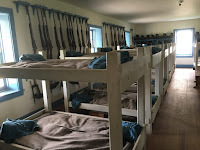 |
| Bent's Old Fort NHS |
 |
Bent's Old Fort - pano as you
walk in gate |
We continued north, following the route of the Santa Fe
Trail mountain route, into Colorado and headed across the southeast corner of
the state to
Bent’s Old Fort National Historic Site near La Junta. This National Park
Service site has a precise replica of the Trading Fort built by Charles and
William Bent and their partner Ceran St. Vrain in 1833. It is very precise
because of drawings, including measurements, done by an army engineer
(Lieutenant James Abert) while at the fort recuperating from illness in 1845-46.
The fort thrived for approximately 18 years in its strategic location that attracted trappers from the Rockies, furs from the natives throughout the plains, and Mexicans
from the south.
 |
Bent's Old Fort from upper level
looking toward back of the fort |
Because of their effectiveness with working with the natives,
the fort was used as the headquarters for the Indian Agency. It also later
became a military staging point for the U.S. invasion of Mexico. Not only is
the history of the fort amazing, this re-creation is, as well. The Park Service
did an outstanding job in the reconstruction including furnishings to give you
a real feel for the life in the fort. They have an excellent film that provides
the requisite lesson before touring the fort. We highly recommend a visit here. Note: the insides of the rooms throughout the fort are very well done with furnishings but I didn't get any good pictures.
 |
Bent's Old Fort looking down from
upper level to gate |
 |
Boot Hill Museum
boardwalk |
We continued on to Dodge City, Kansas so we could get some
history of the famous town from the
Boot Hill Museum. This museum is
privately owned and operated and is nicely done. It does a good job giving the
history of the town including a lot of artifacts from the area. The main old
part of the town burned long ago but they have built era accurate buildings
(can’t call them replicas) and filled them with period furnishings and artifacts
from the area to give you a sense of life in Dodge. The museum has both a traditional
type exhibit building and a street of buildings, complete with boardwalk,
that you walk through.
 |
| Fort Larned |
 |
Fort Larned - some buildings
across parade grounds |
From Dodge City we angled northeast along the Santa Fe Trail
to
Fort Larned National Historic Site. This fort was first established
in 1860 with rough wood and adobe structures and in 1866-68 civilian contractors
built ten permanent stone structures of which nine still exist and are
preserved at this site. This fort was established to protect travelers on the
Santa Fe Trail as well as to establish peace with the natives. The latter failed
miserably. Once again, the NPS has done a great job shoring up the buildings
and furnishing them so you can walk around and get a sense of what life was
like for the people that lived at the fort. The visitor center also has a good
film that gives the history lesson for the fort. Another place worth a visit.
 |
Fort Larned - Officers Quarters
across parade grounds |
 |
| Fort Larned |
 |
| Fort Larned Officer's Quarter |
On to the Wichita, KS area. Another historical town (I read a
lot of western history books so these two stops are big for me) on the Arkansas
River steeped with history of the cattle drives and cowboys. This is not on the
Santa Fe Trail, we had to drop south to Wichita to go to the
Old Cowtown Museum,
which isn’t a traditional museum, but a little western town with a mix of 27 original mid to late 1800 buildings and another 27 replicas setup for
you to enjoy the western town experience. It is yet another very well-done
place to visit. We also got lucky and went on Sunday when it has free admission
(although it would have been worth it to pay).
 |
| Fort Larned inside Barracks |
We are on a roll – what a bunch of fantastic history
and we are only 12 days out on this road trip. Seven NPS sites and two
wonderful private museums that have been great. Stay tuned for more travels.
 |
Old Cowtown Museum - Munger
house (1868) on left and Trapper
cabin on right (1865) |
 |
| Old Cowtown Museum street |
 |
Old Cowtown Museum - inside
General Store (1884) |
 |
| Old Cowtown Museum street |
 |
Old Cowtown Museum - Murdock
house (1874) |
 |
| Old Cowtown Museum - Murdock house |
